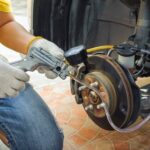Push starting a car, also known as bump starting or roll starting, is a method of getting a manual transmission vehicle started without using the starter motor. It involves using the car’s momentum to turn the engine over and initiate the combustion process. This article clarifies common misconceptions about push starting and explains the process.
Debunking the Alternator Myth
A common misunderstanding is that simply rotating the alternator generates enough electricity to start a car. This is incorrect. While an alternator does produce electricity when spun, it requires an initial electrical current to create the magnetic field necessary for electricity generation. This initial current comes from the battery. With a dead battery, there’s no initial current to energize the alternator’s magnetic field, thus no power generation.
Furthermore, modern cars rely on electric fuel pumps to prime the fuel system. A dead battery prevents the fuel pump from operating, making push starting impossible even if the alternator could magically generate power on its own. Turning the key to the “on” position engages the fuel pump, drawing power from the battery. Without sufficient battery power, the engine won’t receive fuel.
The Mechanics of Push Starting
Push Starting A Manual Car relies on the basic principles of internal combustion. By engaging a gear while the car is moving, the wheels’ rotation forces the engine’s crankshaft to turn. This, in turn, moves the pistons, draws in air and fuel, and compresses the mixture. When the ignition system sparks, the compressed mixture ignites, starting the engine. Here’s a step-by-step guide:
- Find a slight downhill slope or enlist help to push. A slight decline assists with gaining momentum.
- Turn the ignition key to the “on” position. This activates the electrical systems necessary for ignition. However, if the battery is completely dead, push starting might still be impossible due to the fuel pump issue mentioned earlier.
- Press the clutch pedal fully. This disengages the engine from the transmission.
- Put the car in second gear. Second gear provides a good balance between speed and torque for starting. Avoid first gear, as its higher gear ratio might cause the car to jerk and stall abruptly once the engine starts.
- Begin rolling the car. Have helpers push or let the car roll downhill. Reach a speed of at least 5 mph.
- Quickly release the clutch pedal. This suddenly engages the engine with the rotating wheels, forcing the crankshaft to turn. The engine should fire up.
- Press the clutch pedal and let the engine idle. Once the engine starts, immediately disengage the clutch to prevent stalling.
Modern Car Considerations and Precautions
While push starting is possible in many manual transmission vehicles, modern cars with complex electronic systems may be more challenging or even impossible to push start. Always consult the owner’s manual for specific recommendations, as attempting to push start against manufacturer guidelines could potentially damage the vehicle. While personal anecdotes exist about accidentally push starting a modern car, relying on the manufacturer’s instructions is always recommended.
Conclusion
Push starting a manual car is a viable technique in certain situations, relying on momentum to initiate the engine’s combustion cycle. However, it’s crucial to understand the underlying principles and debunk the myth of the self-sufficient alternator. With a dead battery, modern cars often require a jump start or a battery replacement. Always refer to your owner’s manual for specific instructions and recommendations regarding push starting your vehicle.


